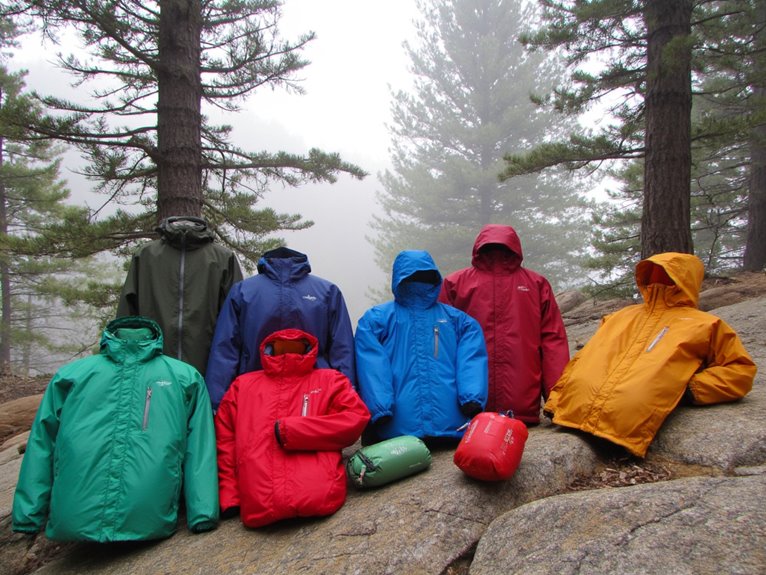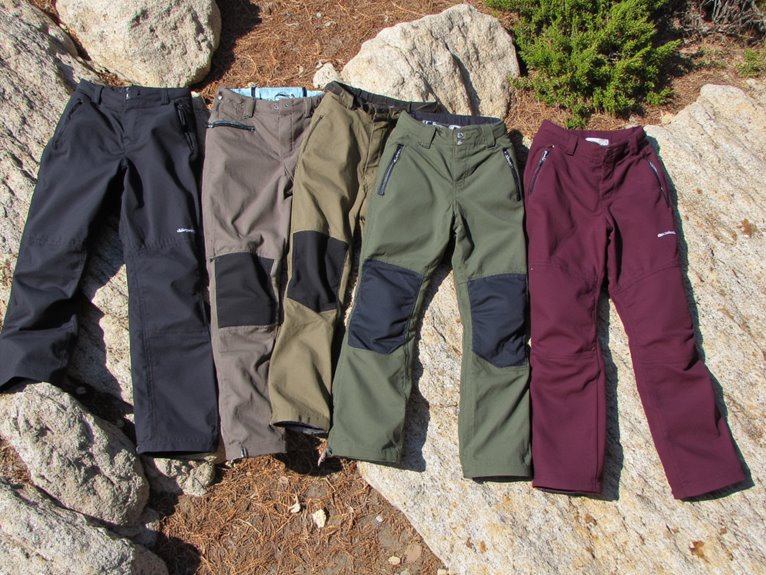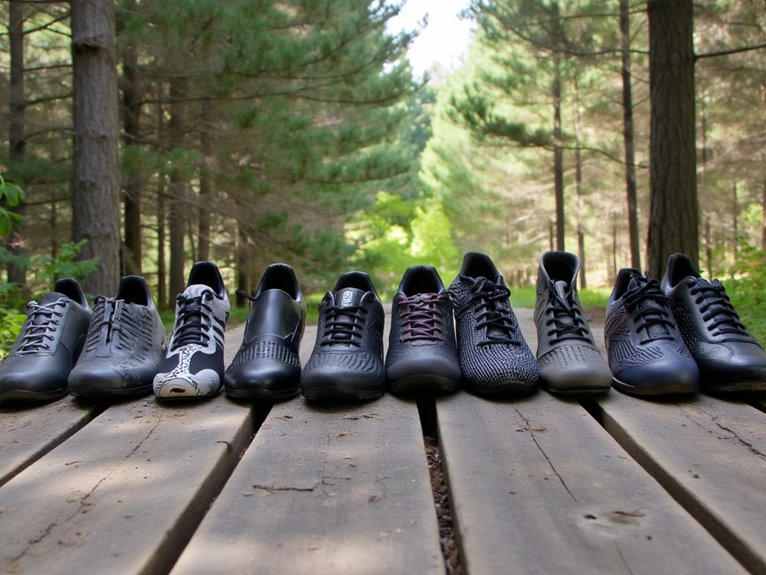Wilderness First Aid for Backpackers: Beyond Basic Cuts and Scrapes
You’ll need advanced wilderness first aid skills beyond basic wound care when you’re hours from medical help. Master the ABCDE assessment protocol, tourniquet placement 2-3 inches above severe wounds, and recognizing heat stroke symptoms above 104°F. Learn epinephrine auto-injector techniques for anaphylaxis, improvised splinting with trekking poles, and infection prevention through proper wound irrigation. Wilderness First Aid certification requires 16 hours of training costing $245-$420, emphasizing decision-making under adverse conditions where your skills determine evacuation necessity and patient outcomes.
We are supported by our audience. When you purchase through links on our site, we may earn an affiliate commission, at no extra cost for you. Learn more. Last update on 7th January 2026 / Images from Amazon Product Advertising API.
Notable Insights
- Master severe bleeding control using tourniquets placed 2-3 inches above wounds and direct pressure for minimum 5-10 minutes.
- Recognize life-threatening anaphylaxis symptoms and practice epinephrine auto-injector administration techniques for emergency treatment in remote areas.
- Identify environmental emergencies like heat stroke above 104°F, frostbite, and altitude sickness symptoms above 2,500 meters elevation.
- Use ABCDE protocol for systematic patient assessment prioritizing airway, breathing, circulation, disability, and exposure in wilderness settings.
- Create improvised medical equipment from hiking gear including trekking pole splints, sleeping pad padding, and emergency blankets.
Assessment and Prioritization in Remote Settings
When someone suffers an injury in the backcountry, your response must follow a systematic approach that prioritizes both safety and life-threatening conditions.
Begin with scene assessment to identify environmental hazards like unstable terrain or wildlife threats. Secure the area before advancing to patient contact.
Scene safety comes first-assess environmental dangers and secure the area before approaching any injured person in the wilderness.
Execute patient assessment using the ABCDE protocol: Airway, Breathing, Circulation, Disability, and Expose.
Check airway obstructions first, then evaluate respiratory function by observing chest movement and listening for breath sounds. Assess pulse quality and scan for major bleeding.
Monitor neurological status while protecting suspected spinal injuries.
Remote considerations demand heightened vigilance due to limited medical resources. Environmental extremes affect patient stability and evacuation timing.
Document all findings meticulously for care continuity.
Prioritize life-threatening conditions immediately while maintaining your own safety throughout the response.
Since backpacking gear weight significantly impacts mobility during emergency response, ensure your first aid kit uses lightweight materials that won’t compromise your ability to reach injured team members or evacuate efficiently.
Severe Bleeding Control and Trauma Management
When you’re dealing with severe bleeding in the wilderness, your ability to control hemorrhaging can mean the difference between life and death for an injured hiker.
You’ll need to master three critical techniques: applying direct pressure with proper wound packing methods, executing tourniquet placement protocols when arterial bleeding threatens life, and creating improvised splints to stabilize fractures that complicate trauma management.
These interventions must be performed quickly and correctly since evacuation times in remote areas can extend for hours or even days.
Direct Pressure Techniques
Direct pressure represents the most critical intervention you can perform to control severe bleeding in wilderness emergencies. Apply firm, consistent pressure using finger pads or heel of your hand directly over the bleeding source.
Don’t release pressure intermittently to check progress-maintain continuous force for 5-10 minutes minimum.
Use sterile gauze when available, but clean cloth or bare hands work in emergencies. Roll gauze into deep wounds to promote coagulation and improve control effectiveness. Elevate injured limbs above heart level when safely possible to reduce hydrostatic pressure.
For deep wounds requiring wound packing, press gauze firmly into the wound cavity, then maintain surface pressure. Combine direct pressure with compression bandages to sustain force while allowing limited mobility.
Repositioning may be necessary if bleeding continues.
Tourniquet Application Protocol
Although direct pressure controls most bleeding situations, severe extremity hemorrhage sometimes requires immediate tourniquet application to prevent life-threatening blood loss. Despite common tourniquet misconceptions about causing permanent damage, proper application saves lives when bleeding exceeds your ability to control it manually.
Place the tourniquet 2-3 inches above the wound, avoiding joints. Tighten the windlass until bleeding stops completely. Document application time immediately.
| Step | Action |
|---|---|
| Position | 2-3 inches proximal to wound |
| Secure | Wrap strap, pull tight manually |
| Tighten | Twist windlass until bleeding stops |
| Document | Mark exact application time |
When commercial tourniquets aren’t available, tourniquet alternatives like improvised pressure bandages rarely achieve adequate compression. A second tourniquet applied proximally provides backup if initial placement fails. For remote wilderness situations where emergency communication may be necessary, GPS devices with satellite SOS capabilities can summon help when medical emergencies exceed your first aid training.
Improvised Splinting Methods
Three critical factors determine splinting success in wilderness settings: material selection, immobilization technique, and integration with bleeding control protocols.
Your backpack contains numerous splint materials. Trekking poles and rigid sticks provide structural support, while puffy jackets offer essential padding. T-shirts and scarves create effective slings for upper extremity injuries.
Effective splint stabilization requires these components:
- Rigid framework extending beyond joints above and below the injury
- Layered padding between skin and hard surfaces to prevent pressure sores
- Secure fastening that won’t loosen during evacuation movement
- Circulation monitoring access to check distal pulses and sensation
Control bleeding first with direct pressure before splinting.
Position the injured limb comfortably, then apply your improvised splint firmly without restricting blood flow.
Check circulation every fifteen minutes during transport.
Environmental Emergencies: Heat, Cold, and Altitude
When you’re miles from the nearest hospital, environmental emergencies become some of the most dangerous threats you’ll face in the wilderness.
Heat illness progresses from exhaustion to life-threatening stroke when core temperature exceeds 40°C (104°F). Cold injury ranges from reversible frostnip to severe frostbite requiring immediate rewarming in 37-39°C water.
Environmental emergencies span a deadly spectrum-from heat stroke at 40°C to frostbite requiring immediate water rewarming at body temperature.
Altitude sickness strikes above 2,500 meters, causing headaches and nausea within 6-12 hours.
Prevention strategies prove more effective than treatment.
Layer moisture-wicking clothing for cold conditions. Hydrate regularly and wear light colors in heat. Ascend gradually at altitude-no more than 500 meters daily above 3,000 meters.
Monitor early warning signs: excessive sweating or its absence, uncontrolled shivering, persistent headaches.
Environmental emergencies escalate rapidly, making recognition and immediate intervention critical for survival.
Medical Emergencies and Medication Administration
When you’re miles from medical help, your ability to recognize severe allergic reactions and administer life-saving medications can mean the difference between a successful rescue and a tragedy.
You’ll need to master epinephrine auto-injector techniques, understand proper medication storage in extreme conditions, and maintain accurate dosage records for emergency responders.
Your medication kit must include essential drugs with clear expiration dates, proper storage requirements, and documented administration protocols that follow wilderness medical standards.
Anaphylaxis and Epinephrine Use
Although anaphylaxis represents one of the most dangerous medical emergencies you’ll face in the wilderness, recognizing its symptoms and administering epinephrine correctly can save a life.
This severe allergic reaction affects multiple body systems simultaneously. Watch for respiratory distress, generalized hives, facial swelling, and cardiovascular collapse.
Proper epinephrine administration follows these critical steps:
- Dosage: Use 0.3 mg for adults, 0.15 mg for children weighing 33-66 pounds
- Location: Inject into the lateral thigh muscle through clothing if necessary
- Timing: Repeat every 5 minutes if symptoms worsen, every 15 minutes if unchanged
- Maximum: Limit to three doses unless medical evacuation arrives
Position the patient face-up unless vomiting occurs. Loosen restrictive clothing immediately.
Prepare for potential biphasic reactions within 24 hours post-treatment.
Essential Medication Selection
Beyond emergency interventions like epinephrine, your wilderness first aid kit requires a carefully selected range of medications that address common medical situations you’ll encounter miles from professional care.
Essential medication selection for wilderness first aid focuses on treating hypoglycemia, pain, inflammation, allergic reactions, and gastrointestinal issues.
Pack oral glucose for diabetic emergencies and energy depletion. Include ibuprofen or aspirin for analgesic, anti-inflammatory, and antipyretic effects.
Antihistamines counter allergic reactions from insect bites and environmental allergens. Add antidiarrheal medications and oral rehydration salts for gastrointestinal problems and dehydration management.
Your topical agents should include triple antibiotic ointment and hydrocortisone creams for infection prevention and inflammation reduction.
Benzalkonium chloride-based antiseptic wipes provide initial wound cleaning. Each medication serves multiple functions while maintaining compact, lightweight packaging essential for backcountry travel.
Dosage Documentation Protocols
Proper documentation protocols transform chaotic emergency situations into organized medical records that can save lives and protect practitioners from liability.
You’ll need systematic documentation for dosage accuracy and administration routes during medication delivery. The SOAP format provides structure for wilderness emergencies where communication delays occur frequently.
Your documentation must include these critical elements:
- Vital signs and timing – Record baseline measurements before medication administration.
- Exact dosages and routes – Document 0.3cc epinephrine IM or 40-60mg oral antihistamines precisely.
- Patient responses and changes – Note symptom progression and medication effectiveness.
- Practitioner credentials and authorization – Include certification level and medical director approval.
Record every medication administered, especially during anaphylaxis treatment.
Include your name, certification level, and relevant protocol references.
Document evacuation decisions and condition changes to support continuing care in hospital settings.
Wound Care and Infection Prevention
Anyone venturing into the backcountry must master wound care fundamentals, as even minor cuts can become serious infections when you’re miles from medical help. Proper wound irrigation using filtered water and an irrigation syringe removes debris more effectively than topical antibiotics. Focus on thorough mechanical cleaning rather than chemical solutions.
Essential dressing techniques require sterile 4×4 gauze pads for bleeding control and initial coverage. Change dressings when wet, dirty, or daily minimum. Clean around wounds with alcohol, but never inside the wound itself.
| Infection Signs | Immediate Action | Evacuation Timeline |
|---|---|---|
| Redness, swelling, warmth | Hot compresses, oral antibiotics | Monitor 12 hours |
| Pus, foul odor | Clean, redress frequently | Prepare evacuation |
| Fever, streaking | Begin evacuation protocols | Immediate departure |
| Swollen lymph nodes | Continue antibiotics | Emergency evacuation |
Recognition and response determine outcomes in remote settings.
Keep your first aid kit in an easily accessible external pocket or attached with carabiners to your pack, as emergency situations require immediate access to gauze pads, antiseptics, and other essential medical supplies.
Improvised Medical Equipment and Field Expedients
When standard medical supplies aren’t available in the wilderness, you’ll need to transform everyday backpacking gear into life-saving equipment. Your sleeping pad becomes splint padding. Hiking poles serve as rigid support structures for fractures. Guy lines from tents work as adjustable ties that won’t cut circulation.
Essential improvised medical equipment includes:
- Splinting materials – Pack stays, poles, and foam padding create effective immobilization systems.
- Improvised bandaging – Clean clothing strips and duct tape secure wound dressings when gauze isn’t available.
- Airway adjuncts – Plastic tubing from hydration systems can fashion emergency suction devices.
- Protection barriers – Tarps provide sterile surfaces and weather protection for treatment areas.
Your multi-tool cuts materials precisely. Resealable bags waterproof medications. Emergency blankets prevent shock while maintaining patient warmth. Power banks with built-in flashlights provide essential illumination for nighttime medical procedures and emergency situations.
Patient Monitoring During Extended Care
Once you’ve stabilized an injured backpacker, continuous monitoring becomes your primary responsibility until evacuation arrives. Document essential signs every 15 minutes using a piece of tape on your gear. Record heart rate, respiratory rate, blood pressure if possible, and skin temperature. Note the exact time for each assessment.
Conduct head-to-toe examinations hourly to identify changes in condition. Monitor skin color, temperature, and moisture levels as circulation indicators. Track level of consciousness using simple questions about person, place, and time.
Maintain detailed patient history documentation throughout care. Record all treatments administered, medications given, and responses observed. Compare current readings to baseline measurements to identify trends.
Environmental factors like temperature and altitude affect readings, so note conditions alongside essential signs for accurate assessment.
Documentation and Communication for Evacuation
Three critical components form the foundation of effective evacuation communication: proper documentation using SOAP notes, clear verbal reports to emergency services, and systematic information gathering that guarantees nothing gets overlooked.
Documentation essentials include recording patient demographics, essential signs, and treatment plans. SOAP notes serve as legal records. You’ll need these details when emergency services arrive. Patient privacy remains paramount during information sharing.
Document patient demographics, vital signs, and treatment plans in SOAP notes-these legal records are essential when emergency services arrive.
Follow this evacuation communication protocol:
- Assess scene safety before initiating any communication procedures
- Gather SAMPLE history including allergies, medications, and past medical conditions
- Document red flag symptoms that necessitate immediate evacuation
- Establish reliable emergency contact using available communication methods
Weather conditions affect evacuation routes.
Contact emergency services promptly, even if immediate help isn’t required. Your clear, concise verbal reports enable responders to prepare appropriate resources and personnel. Emergency radios with NOAA weather alerts provide critical information about severe weather conditions that could impact evacuation timing and route selection.
Training Requirements and Skill Development
Proper wilderness medical training transforms your ability to handle emergencies that occur hours or days from professional help.
WFA courses require 16 hours over two days with minimal training prerequisites-you’ll need to be 16 years or older. Tuition ranges from $245 to $420 depending on certification scope.
WFR training demands 80 hours for serious backcountry users facing extended care scenarios.
Skill enhancement focuses on the Patient Assessment System for evaluating injury severity in remote conditions. You’ll practice treating wounds, fractures, burns, and administering epinephrine auto-injectors.
Training combines classroom instruction with outdoor simulations under adverse weather conditions. Courses develop evacuation decision-making skills based on injury assessment and environmental factors.
Most programs include CPR certification and wilderness-specific first aid kit assembly techniques.
Frequently Asked Questions
What Legal Liability Do I Face When Providing Wilderness First Aid to Strangers?
You’ll face minimal legal liability when providing wilderness first aid to strangers. Good Samaritan laws protect volunteers acting in good faith during emergencies.
You’re not legally required to help strangers, but once you start, you must continue with reasonable care. Medical malpractice considerations don’t typically apply since you’re held to wilderness standards, not professional medical standards.
Document your actions and stay within your training level.
How Do I Handle Psychiatric Emergencies or Panic Attacks in Remote Locations?
You’ll need effective panic management techniques in remote settings.
Create a calm environment and use grounding exercises like controlled breathing or sensory focus.
Practice wilderness counseling by listening without judgment and validating feelings.
Monitor for suicidal ideation constantly.
Keep the patient hydrated and comfortable.
Document everything meticulously.
Evacuate immediately if symptoms persist or worsen drastically.
Can I Perform Wilderness First Aid if I Have My Own Medical Conditions?
You can perform wilderness first aid with medical conditions, but self awareness strategies are essential. Assess your limitations honestly before departing.
Certain conditions like severe arthritis or vision impairment may restrict your ability to perform CPR or precise wound care.
Personal risk management requires carrying extra medications, informing teammates about your condition, and designating backup responders.
Practice skills beforehand to identify physical constraints and adapt techniques accordingly.
What’s the Difference Between Wilderness First Aid and Urban Emergency Medical Protocols?
You’ll encounter significant wilderness protocol differences compared to urban emergency response techniques.
Urban protocols assume 8-15 minute EMS arrival, focusing on stabilization and rapid transport. Wilderness protocols authorize extended care for hours or days, including spine clearing, dislocation reduction, and medication administration typically restricted to paramedics.
You’ll need broader medical skills, compact equipment, and self-sufficiency planning since professional backup isn’t available.
How Do I Manage Diabetic Emergencies When Glucose Supplies Are Limited?
You’ll need glucose alternatives when standard supplies run low. Emergency snacks like dried fruit, honey packets, or hard candy work effectively.
Give 15-20 grams of simple carbohydrates every 15 minutes until symptoms improve. Sports drinks provide both glucose and electrolytes if available.
Monitor blood sugar levels closely and cease all physical activity immediately. Follow up with complex carbohydrates once initial hypoglycemia resolves to maintain stable levels.
On a final note
You’ve learned essential wilderness first aid skills that extend far beyond treating minor injuries. These techniques can save lives when you’re hours from professional help. Practice these skills regularly through hands-on training courses and scenario-based exercises. Maintain your equipment and update your knowledge annually. Remember: proper assessment, decisive action, and continuous monitoring are your strongest tools in remote emergencies. Your preparation today determines your effectiveness tomorrow.



